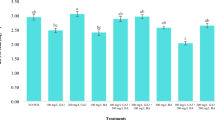Summary
Seedlings of Scrophularia marilandica were grown at different combinations of day/night temperature and photoperiod under controlled conditions. The species flowered in long days. The stems of plants grown at low temperature and short photoperiod failed to elongate. Treatment with gibberellic acid (GA3) simulated the effect of increasing temperature and photoperiod and caused stem elongation in plants which would otherwise not have elongated. Application of GA3 to plants grown at high temperature and long photoperiod resulted in increased stem elongation and flowering. The growth retardant (2-chloroethyl)trimethylammonium chloride (CCC) had little effect on rosette plants grown at low temperature and short photoperiod. Application of CCC to +GA3 plants grown at a higher temperature and long photoperiod gave a significant increase in stem height. The interaction between temperature and applied GA is described in an experiment using plants grown at high and low temperatures for varying periods of time.
Similar content being viewed by others
References
Baldev, B., Lang, A.: Control of flower formation by growth retardants and gibberellin in Samolus parviflorus, a long-day plant. Amer. J. Bot. 52, 408–417 (1965).
Barnes, M. F., Light, E. N., Lang, A.: The action of plant growth retardants on terpenoid biosynthesis: Inhibition of gibberellic-acid production in Fusarium moniliforme by CCC and AMO-1618; action of these retardants on sterol biosynthesis. Plant (Berl.) 88, 172–182 (1969).
Caso, O. H., Kefford, N. P.: The bolting and flowering of Chondrilla juncea L. as influenced by temperature and photoperiod. Aust. J. biol. Sci. 21, 883–894 (1968).
Cline, M. G.: Effects of temperature and light intensity on the growth of Scrophularia marilandica. Ecology 47, 782–795 (1966).
Dennis, D. T., Upper, C. D., West, C. A.: An enzymic site of inhibition of gibberellin biosynthesis by AMO 1618 and other plant growth retardants. Plant Physiol. 40, 948–952 (1965).
Halevy, A. H., Wittwer, S. H.: Growth promotion in the snapdragon by CCC, a growth retardant. Naturwissenschaften 52, 310 (1965).
Ninnemann, H., Zeevaart, J. A. D., Kende, H., Lang, A.: The plant growth retardant CCC as inhibitor of gibberellin biosynthesis in Fusarium moniliforme. Planta (Berl.) 61, 229–235 (1964).
Wünsche, U.: Growth retarding and stimulating effects of CCC on Antirrhinum majus L. Planta (Berl.) 85, 108–110 (1969).
Zeevaart, J. A. D.: Reduction of the gibberellin content of Pharbitis seeds by CCC and after-effects in the progeny. Plant Physiol. 41, 856–862 (1966).
Author information
Authors and Affiliations
Additional information
This work was supported by National Science Foundation Grant GB 17483.
Rights and permissions
About this article
Cite this article
Groves, R.H., Lang, A. Environmental control of growth and development of Scrophularia marilandica . Planta 91, 212–219 (1970). https://doi.org/10.1007/BF00385480
Received:
Issue Date:
DOI: https://doi.org/10.1007/BF00385480




